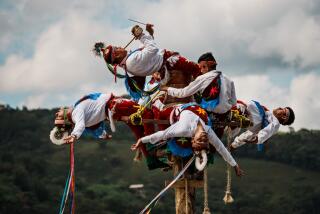Birds flying in a V take turns in the top spot, study finds
- Share via
It take a flock to fly. Over grueling, dangerous flights, Northern bald ibises will take turns at the toughest job during their migration -- leading the V-shaped formation, a new study finds.
The findings, described in the Proceedings of the National Academy of Sciences, shed fresh light on how these long-distance aviators work together to survive these arduous journeys.
V-formation flight has fascinated humans for thousands of years, said study lead author Bernhard Voelkl, a biologist at the University of Oxford, noting that the ancient Egyptians and Greeks observed this phenomenon. But why they do it, and how, had remained largely unstudied until recent decades.
“I’ve been waiting for 40 years for someone to solve this problem,” said Robert Trivers, an evolutionary biologist at Rutgers University who was not involved in the study. “V-formations are very, very obvious. They cannot be accidental and they cannot be trivial, because the birds do them. They do them all the time.”
A recent paper by Voelkl and colleagues revealed how the Northern bald ibis flies in a V to get a little extra lift from the wake of the bird in front of them. Since this saves them a little energy, it can be a real lifesaver over the long haul. That’s great news for most of the birds, but it means the lead bird at the point of the V is doing a lot of work without getting any extra help. How do the birds decide who takes this tough spot?
To find out, the scientists worked with the Austrian-based conservation group Waldrappteam, which is trying to bring the critically endangered birds (known formally as Geronticus eremita) back from the brink. The group raises the ibis chicks in captivity at the Salzburg Zoo in Austria and then, akin to the Canada goose migration in the 1996 film “Fly Away Home,” uses an ultralight aircraft to lead them on their first cross-country trip to their winter getaway in Italy.
For the study, the researchers equipped a flock of 14 young ibises with data loggers containing very precise GPS monitors that could tell, within about 20 centimeters, where they were in relation to the other birds, Voelkl said. The scientists tracked the young ibises from the ground for several weeks as a pilot and a human foster parent flew the route with the flock.
As it turned out, no single bird took the top spot for an extended period of time. Each ibis would typically spend less than a minute, perhaps just a few seconds, at the vertex of the V before quickly switching with one of the next birds in the formation.
In a one-hour flight, each bird would do a pair-switch with its nearest neighbor an average of 57 times, Voelkl said. On a typical flight, which could last around three to eight hours, each bird would perform hundreds of switches. The transitions were nearly seamless, Voelkl said, usually taking about a second to execute.
And while each of those individual stints at the top wasn’t equal, on average, the birds all ended up doing roughly the same amount of work. That was in part because the ibises weren’t often in a 14-strong flock; they sometimes broke up into formations of two or three or four birds at a time. The birds would also often scrunch together and reorganize, shuffling the flying order dramatically.
“All the birds contribute almost equally to the investment in leading the flock,” Voelkl said. “This was surprising to us.”
For young birds like these, their first journey (which can stretch a thousand miles or more) can be grueling and deadly -- the mortality rate can reach 30%, Voelkl said. So why equally share the burden? Why don’t some of the birds try to ‘cheat,’ and let other birds pick up the slack?
This sort of cooperative behavior is of great interest to scientists. Often, it’s found that animals will help other animals out, even if it isn’t in their self-interest, if they’re related to that animal. There’s a good evolutionary reason for this: It means that they’re helping another creature carrying at least some of their shared genes to survive and pass them on to the next generation.
But in this case, the researchers found that the birds helped each other out regardless of whether they were related (and also regardless of the social hierarchy within the flock).
The study sheds more light on the complexities of V-formation flight, and on the evolutionary drivers behind the birds’ apparently ‘selfless’ acts of reciprocal altruism. Next up, Voelkl said, the researchers want to measure the heart rate of the birds, and get a measurement of exactly how much energy they save in V-formation.
Take flight with science! Follow @aminawrite for more science news from the animal kingdom.







